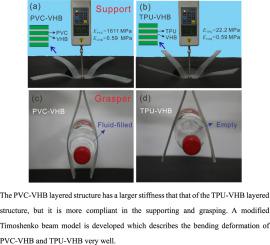Extreme Mechanics Letters ( IF 4.3 ) Pub Date : 2020-06-01 , DOI: 10.1016/j.eml.2020.100799 Huasong Qin , Yingbo Yan , Huichao Liu , Jingran Liu , Yong-Wei Zhang , Yilun Liu

|
Layered materials and structures (LMS), such as van der Waals two-dimensional (2D) layered materials and nacre-like layered structures, often exhibit highly anisotropic mechanical properties, i.e., strong in in-plane directions but weak in out-of-plane direction. Despite the strong anisotropy in their mechanical properties, Timoshenko beam model (TBM) is usually used to describe the bending deformation of LMS. We note, however, that there are two fundamental issues in using TBM to describe LMS: First, the stiffness of LMS approaches zero when the interlayer shear modulus G approaches zero; and second, the first derivative of deflection becomes discontinuous at the point of concentrated force. Clearly, both are not true for LMS. In this work, by introducing the bending energy of monolayer into the potential energy of TBM, we develop a modified Timoshenko beam model (MTBM), which is able to not only address these two issues, but also correctly predict the bending stiffness of LMS without any fitting parameters. Our analysis shows that the bending behaviors of LMS are determined by a dimensionless parameter L, where L is the length of the beam and , where, kGA and are, respectively, the shear and bending rigidity of the beam cross-section, is the bending rigidity of monolayer, and n is the number of layer. When , the MTBM degenerates to the multi-beam model with bending stiffness of ; while it degenerates to the TBM when. Furthermore, if kGA is much larger than , both MTBM and TBM degenerate to the classical Euler–Bernoulli beam model. We further perform molecular dynamics simulations, finite element simulations and experiments to validate the MTBM. Based on the MTBM, a couple of interesting applications of LMS are also demonstrated. Hence, the MTBM presented here captures the necessary intrinsic deformation modes of LMS and provides an accurate tool for the prediction and optimization of the mechanical properties of LMS.
中文翻译:

修正的Timoshenko梁模型用于层状材料和结构的弯曲行为
诸如Van der Waals二维(2D)层状材料和珍珠层状层状结构的层状材料和结构(LMS)通常表现出高度各向异性的机械性能,即,在面内方向上较强,而在面外方向上较弱。平面方向。尽管它们的机械性能具有很强的各向异性,但蒂莫申科梁模型(TBM)通常用于描述LMS的弯曲变形。但是,我们注意到,使用TBM来描述LMS有两个基本问题:首先,当层间剪切模量G时LMS的刚度接近零接近零;第二,挠度的一阶导数在集中力点变得不连续。显然,对于LMS而言,两者都不是正确的。在这项工作中,通过将单层的弯曲能引入到TBM的势能中,我们开发了改良的Timoshenko梁模型(MTBM),该模型不仅可以解决这两个问题,而且可以正确预测LMS的弯曲刚度任何拟合参数。我们的分析表明,LMS的弯曲行为由无量纲参数决定L,其中L是光束的长度,,其中,kGA和 分别是梁截面的抗剪刚度和抗弯刚度, 是单层的弯曲刚度,n是层数。什么时候,MTBM退化为弯曲刚度为 ; 当它退化为TBM时。此外,如果kGA远大于,MTBM和TBM都退化为经典的Euler–Bernoulli梁模型。我们进一步进行分子动力学模拟,有限元模拟和实验以验证MTBM。基于MTBM,还展示了LMS的一些有趣的应用。因此,此处介绍的MTBM捕获了LMS必要的固有变形模式,并为LMS力学性能的预测和优化提供了准确的工具。











































 京公网安备 11010802027423号
京公网安备 11010802027423号